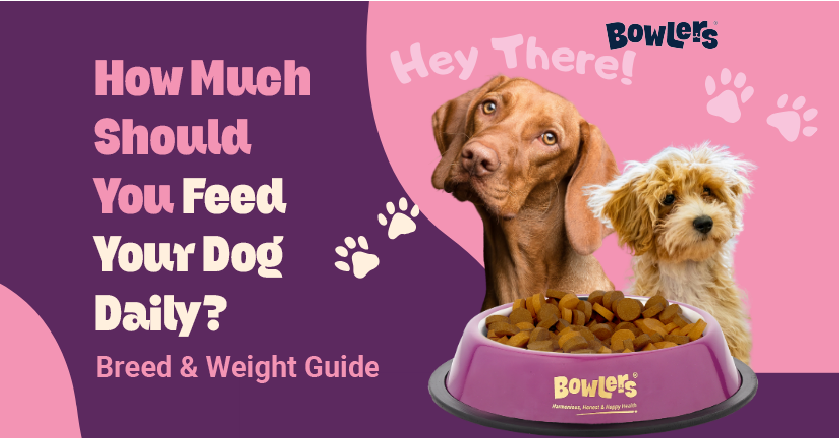How Much Should You Feed Your Dog Daily? Breed & Weight Guide

Table of contents
- Why Feeding Amounts Matter
- Factors That Affect How Much to Feed Your Dog
- Dog Diet Chart: Feeding by Weight
- Puppy vs Adult Dog Diet
- Best Feeding Schedule for Dogs
- Signs You are Feeding the Wrong Amount
- Using Labels to Guide Portions
- Tips for Measuring Daily Dog Food Portions
- Special Considerations
- The Bowlers Approach to Feeding
One of the most common questions pet parents ask is: “How much should I feed my dog?” The answer isn’t as simple as one size fits all. Every dog has unique needs depending on age, breed, activity level, and weight. Overfeeding can lead to obesity and health problems, while underfeeding may cause nutrient deficiencies. That’s where a dog diet chart or dog feeding chart by weight can help.
At Bowlers, we believe feeding your pet the right way is as important as choosing the right food. In this guide, you’ll find practical insights on daily dog food portions, the best feeding schedule for dogs, and a breakdown of puppy vs adult dog diet requirements.
Why Feeding Amounts Matter
Food is more than fuel, it is the foundation of your dog’s health. Proper portions help maintain:
- A healthy weight
- Strong bones and muscles
- Balanced energy levels
- Long-term organ health
To understand the bigger picture of nutrients and balance, see our Complete Guide to Dog Nutrition and Balanced Diets.
Factors That Affect How Much to Feed Your Dog
Before looking at charts, consider the factors that influence how much to feed my dog:
- Weight & Breed Size – A Chihuahua’s diet looks very different from a Labrador’s.
- Age – Puppies need more calories per kilogram than adults or seniors.
- Activity Level – Active breeds like Border Collies burn more energy than lap dogs.
- Health Conditions – Dogs with allergies, sensitivities, or medical issues may require a special diet.
- Food Type – Calorie content varies between kibble, wet food, and homemade meals.
Curious about food options? Read our cluster blog: Homemade Dog Food vs Store-Bought: Which is Healthier?
Dog Diet Chart: Feeding by Weight
Check the general dog diet chart based on average calorie needs. Always check the calorie content on your dog’s food packaging and adjust accordingly.
Puppy vs Adult Dog Diet
Puppies have different nutritional needs than adults. They grow rapidly, requiring higher protein, calcium, and calories.
- Puppies (up to 12 months): Feed 3–4 smaller meals daily. Look for DHA and calcium for brain and bone development.
- Adults (1–7 years): Switch to 2 meals a day, focusing on maintaining ideal weight.
- Seniors (7+ years): Lower calories to prevent weight gain, add joint-supporting nutrients.
Learn more about essential add-ons in our cluster blog: Best Supplements for Dogs: Do They Really Need Them?
Best Feeding Schedule for Dogs
Consistency is key. Dogs thrive on routine, so feeding at the same time each day helps with digestion and behavior.
- Puppies: Morning, midday, evening, and bedtime
- Adults: Morning and evening (12 hours apart)
- Seniors: Similar to adults, but with lighter portions if digestion slows
Stick to a schedule and avoid leaving food out all day, which can lead to overeating.
Overfeeding is one of the most frequent errors—see our guide on Common Dog Feeding Mistakes and How to Avoid Them.
Signs You are Feeding the Wrong Amount
Even with a dog diet chart, every dog’s metabolism is unique. Watch for these signs to adjust portions:
- Too little food: Visible ribs, low energy, dull coat
- Too much food: Rapid weight gain, lethargy, begging even after meals
- Balanced diet: Steady weight, bright eyes, healthy stool, active behavior
Using Labels to Guide Portions
The packaging of commercial food often includes a feeding chart. However, not all labels are easy to interpret. Check for:
- Calorie content per cup/100g
- Portion suggestions by weight
- Adjustments for age and activity
To learn more about understanding packaging details, explore: How to Read Dog Food Labels: What Every Pet Parent Should Know
Tips for Measuring Daily Dog Food Portions
- Use a measuring cup or scale – Don’t estimate by eye.
- Adjust with activity – If your dog exercised more today, add a little extra.
- Include treats in the total – Treats shouldn’t exceed 10% of daily calories.
- Transition gradually – When changing portion sizes or food type, adjust slowly to avoid stomach upset.
- Monitor weight regularly – Weigh your dog monthly to track changes.
Special Considerations
Large Breeds
Prone to joint issues, they need controlled portions to avoid rapid weight gain.
Small Breeds
Higher metabolism means they require calorie-dense meals, often in smaller kibble sizes.
Overweight Dogs
Cut back gradually, never drastically. Look for weight-management formulas.
Active or Working Dogs
Require higher calorie intake for sustained energy.
The Bowlers Approach to Feeding
At Bowlers, we design our foods with portion clarity in mind. Each bag includes a scientifically backed dog feeding chart by weight so pet parents can confidently measure meals. Our formulas provide balanced dog food with the right protein, fat, and micronutrients for every life stage.
Pairing our recipes with a consistent feeding schedule ensures your dog thrives with every meal.
“How much should I feed my dog?” doesn’t have one universal answer—but a dog diet chart and weight-based guidelines provide an excellent starting point. By considering your dog’s breed, size, and activity, you can create the right plan for them.
- Puppy vs adult dog diet needs differ greatly—don’t feed them the same.
- Use a dog feeding chart by weight for accurate daily dog food portions.
- Stick to the best feeding schedule for dogs for routine and balance.


